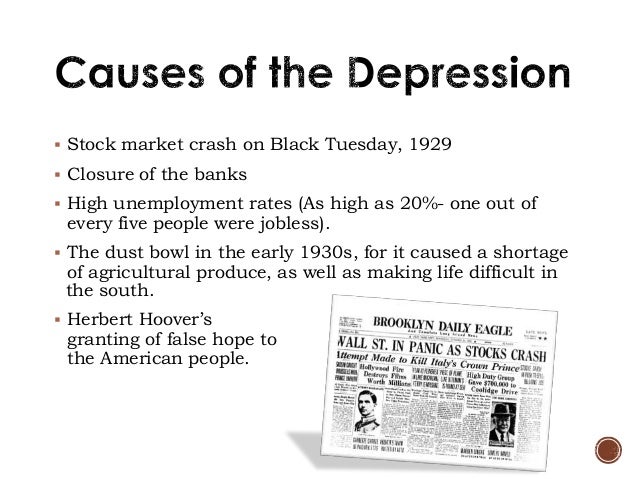Facts about the stock market during the great depression
The Stock Market Crash of was the start of an financial crisis that lasted until the US economy was revitalized through the US involvement in World War II. The circumstances of the Great Depression are very similar to those of the current recession.
On 29 October , the US stock market crashed. The day became forever after known as "Black Tuesday" The so-called "Great Crash" is known by a a variety of monikers including the "Wall Street Crash of " and the "Stock Market Crash of ". It marked the beginning of the Great Depression, a ten-year financial crisis that left the US and the world in desperate straits. It was the biggest financial crisis of the 20th century: Stocks were devalued by more than 80 percent.
Unemployment went up to almost 25 percent. These Stock Market Crash facts define the parameters of the event. The years leading up to "Black Tuesday" were referred to as the "Roaring Twenties. It was a time of wealth and excess.
A famous economist of the time, Irving Fisher, was recorded as saying, "Stock prices have reached what looks like a permanently high plateau. In the week prior to "Black Tuesday", the US stock market was highly unstable.
Interesting Facts about the GREAT DEPRESSION ***
Stock prices rose and fell wildly, surging one minute and ebbing dramatically the next. Periods of high selling were matched with periods of high buying, and the volume of both was significant. On "Black Tuesday", over 16 million shares were traded, a record that was not broken until when there were more significantly more shares on the market.
The stock market began a slide in value on "Black Tuesday"; in total, the stock market declined by 89 percent over the course of the next three years. This crash came on the end of a period of intense speculation.
Not only was speculation heavy in the stock market itself, to the point that people would borrow money to buy stocks, but brokers would lend smaller investors more than 66 percent of the value of the stocks they purchased. More and more people borrowed and invested. The stock market had been rapidly escalating in value since 3 September When on 24 October the stock market began to decline under that 3 September peak, financial crisis and economic chaos ensued.
So many people moved to sell stock that stock shares were rapidly devalued.
There was at the time, no mechanism for government intervention in the financial markets. The government was very small and tended to not intervene in economic issues as the USA had operated under an economic philosophy of Classical Liberalism up to this point in history. The decline in the stock market resulted in the inability of investors to repay their loans. This default in the financial markets is what had such a butterfly effect on the economy, since the losses of the 16 percent of US households were invested in the stock market would not by themselves have wreaked such economic choas.
Banks went under and millions lost all of thier deposits. Many companies went bankrupt. Access to credit was limited and people lost their jobs until over 25 percent of American adults were unemployed. In turn, consumer spending was depressed.

As a result, companies received less revenue, people were laid off, and, eventually, those companies too went bankrupt. Many nations took steps to protect thier domestic industries during the crash.
The USA passed the Smoot-Hawley Act which heavily taxed imports to spur purchases of American-made goods. However, since all of the USA's trading partners immediatly passed similar laws, our export market dissapeared overnight.
International Trade dropped by 50 percent during the crash. The international economic difficulties caused by the Great Depression contributed to the rise of the Nazis in Germany, and compelled Imperial Japan to inveade China for acccess to her markets and resources, so in a way it can be said to have set the stage for WW2.
The GREAT DEPRESSION in 4 MinutesWhen Word War II began in , US unemployment was Although, in total, the US increased deficit spending to over percent the gross domestic product GDP , the end of World War II marked the beginning of the greatest economic boom America had ever experienced, providing the single greatest real-world example of successful Keynesian economics. The US GDP almost doubled from to and over 98 percent of the US population was employed, a record that still stands today.
The Stock Market Crash of is reminiscent of the Recession. In both cases, speculation and an overly optimistic economy lead to over-lending and an ultimate overvaluing of the economy that resulted in a serious downturn.
However, what saved from turning into was the provisions put in place after the Stock Market Crash that precluded anything of that magnitude happening again. For example, federal legislation began to require that all banks have enough cash to cover all of its deposits.
Stock Market Crash of Facts, Causes, Effects
It remains to be seen if the recent reforms will effectively prevent another financial crisis. Prior to "Black Thursday" The years leading up to "Black Tuesday" were referred to as the "Roaring Twenties. The Economics of the Crash The stock market began a slide in value on "Black Tuesday"; in total, the stock market declined by 89 percent over the course of the next three years.
Consequences of the Crash The decline in the stock market resulted in the inability of investors to repay their loans. Rebuilding the Nation When Word War II began in , US unemployment was Understanding the Crash The Stock Market Crash of is reminiscent of the Recession. NY Stock Exchange Trading Floor.

Supplied by the US Federal Government; Public Domain; http: Sign In Join Privacy Policy. What others are reading Assessing Stock Prices With Dividends Using the Gordon Model 3 Ways to Win in a Flailing Market.